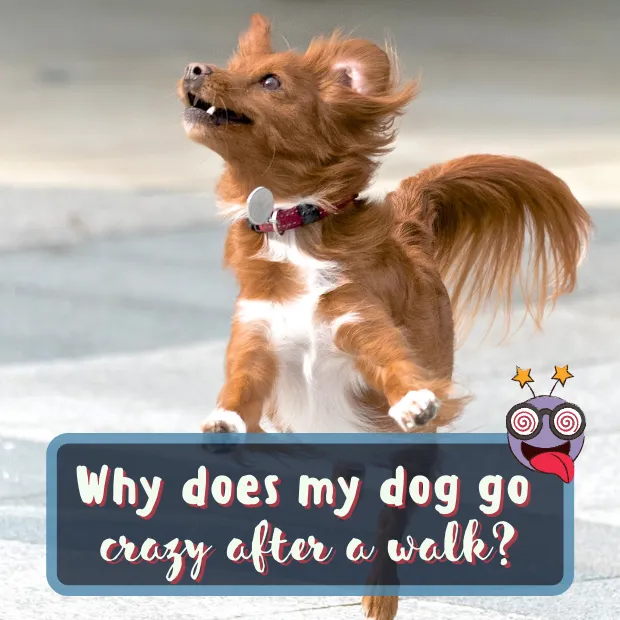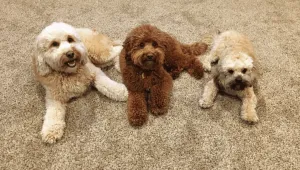It is a scene that is all too familiar to dog owners. You take your dog for a walk, and they seem to have the time of their life. Then you bring them home, and they zoom around the house, running in circles like a mad thing!
But what exactly causes this behavior? Is your dog simply happy to have been outside, or is something else going on? If you’re left wondering, “Just why DOES my dog go crazy after a walk?” read on!
Table of Contents
ToggleContents of this article:
- Why Does My Dog Go Crazy after a Walk?
- What are the Zoomies?
- Why Do Dogs Go Crazy after a Walk?
- How Can I Get My Dog to Calm Down after a Walk?
- Conclusion
Why Does My Dog Go Crazy After a Walk?
In this article, we will explore the phenomenon known as “the zoomies” and provide some possible explanations for why dogs experience it.
We will also offer tips for how you can help your dog calm down after a walk. So, read on to learn more about this interesting behavior!
If you want a calmer dog, check out SpiritDog Training’s Calm Down course. This online program teaches owners how to build trust and calmness in their pet.
What are the Zoomies?
The zoomies, otherwise known as Frenetic Random Activity Periods (FRAP), are a behavior seen in canines of all shapes and sizes. Dogs often become very excited after they have had a stimulating activity such as a long walk or playtime with other dogs.
It is characterized by a sudden burst of energy, during which the dog appears to be out of control and running wildly around the house or yard. The behavior typically lasts only a few minutes and then the dog will calm down on its own.
Why Do Dogs Go Crazy After a Walk?
The phenomenon known as the zoomies, where dogs go crazy after a walk, is due to overstimulation. It is a behavior that many dogs experience as a release mechanism after they have been in an exciting or stressful situation. It happens suddenly, without warning, and can be quite alarming to owners. But what’s the cause?
The hormone cortisol is released when we are stressed. But this same hormone is also released when we are excited. This is also true for dogs. When there is a lot of cortisol in the body, it can cause dogs to become hyperactive and have the zoomies.
Dogs become excited about a walk because they are so happy to be out with their owner. It’s the highlight of their day. But it can make some dogs so overexcited that it can lead to them becoming overstimulated, causing problem behaviors such as height seeking, lead ragging and even grab biting.
Dogs may also run around in circles after being let loose from the leash because they have so much pent up energy from the excitement of going for a walk.
I saw a perfect example of stress zoomies at agility camp a few years ago in a little cockapoo called Mabel, who was quite new to agility.
We were doing a session on how to train the see-saw/teeter totter and the instructor asked Mabel’s owner to take her over the piece of equipment as she would do during her normal practice.
Mabel was sent over the teeter totter and then promptly ran around the field as fast as her little legs would carry her, in an obvious case of the zoomies!
The instructor asked if this was normal for Mabel and the owner responded that she normally holds the teeter totter still and lowers it gently. Goodness only knows why the owner decided not to hold the equipment still like she normally did!
Poor Mabel had received the shock of her life when the teeter totter crashed down because she’d never experienced it before and the zoomies was her stress response to that scary event.
How Can I Get My Dog to Calm Down After a Walk?
After a long walk, most dogs are full of energy and can be quite rambunctious. This can be frustrating for owners who are trying to relax or get things done around the house. Luckily, there are a few simple tricks that can help to calm a dog down after a walk.
One of the best tactics is to do some scatter feeding. Bring your dog home from their walk into the back garden and sprinkle some dried food or treats on the ground for them to find. If you normally give your dog their meal after their walk, you can use this for scatter feeding instead of giving it to them from a bowl.
Another great way to calm a dog down is to provide them with a long lasting natural chew, a stuffed Kong or a Lickimat after their walk. Licking and chewing are natural stress relievers for dogs, and it can help to soothe them after the stimulation of going for a walk.
Finally, it is important to give your dog some time to rest after a walk. A quick nap can do wonders for a hyper dog, and it will help them to be calmer when they wake up.
Conclusion
By following these simple tips, you can help your dog to wind down after an energetic walk.
Now that you know why the zoomies happen and how to calm your dog down after their walk, it’s time to put all of this into practice! Be patient with your pup as they learn the new routine, and soon enough, you’ll both be happy and relaxed after your walks together.







